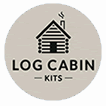Blog
Green Roof Solutions for Log Cabins
Embracing Nature from the Top Down: Green Roof Solutions for Log Cabins
In the quest for a more sustainable and eco-friendly lifestyle, green roof solutions have emerged as a ground-breaking innovation that harmonises architecture with nature. As log cabins continue to captivate homeowners with their rustic charm and back-to-nature appeal, incorporating green roofs has become a popular choice for those seeking a greener and more environmentally conscious living space. In this article, we explore the concept of green roofs for log cabins and how they contribute to a harmonious blend of modern living and natural beauty.
- Understanding Green Roofs:
Green roofs, also known as living roofs or vegetated roofs, are designed to support vegetation and plant life atop a building structure. They involve creating a layer of living plants, soil, and drainage on the roof’s surface, effectively transforming an ordinary rooftop into a thriving ecosystem. Green roofs can be either intensive, featuring a diverse array of plants, or extensive, characterised by a more lightweight and low-maintenance vegetation layer.
- The Ecological Benefits:
Green roof solutions offer a plethora of ecological advantages that align perfectly with the ethos of log cabins as sustainable and nature-centric living spaces. Firstly, green roofs act as natural insulation, reducing energy consumption by maintaining cooler temperatures during summer and enhancing heat retention during winter. This energy efficiency leads to reduced carbon emissions and a smaller environmental footprint.
Secondly, green roofs aid in stormwater management by absorbing rainwater and reducing runoff. This not only mitigates the strain on local drainage systems but also filters pollutants, ensuring cleaner water reaches the ground below.
Thirdly, green roofs provide habitats for various flora and fauna, promoting biodiversity in urban and suburban areas. By creating mini-ecosystems on rooftops, green roofs encourage the return of birds, butterflies, and other pollinators, contributing to the overall health of the ecosystem.
- Aesthetic Appeal and Natural Beauty:
Introducing a green roof to a log cabin enhances its aesthetic appeal and complements the cabin’s connection to nature. The sight of lush vegetation atop the log structure seamlessly integrates the building into the surrounding landscape, making it appear as though the cabin has organically emerged from the earth.
Additionally, green roofs create a serene and calming ambiance, offering residents a soothing view of nature from their windows or terrace. The experience of living amidst a rooftop garden fosters a deeper connection to the outdoors, enhancing the overall sense of well-being and contentment.
- Sustainability and Climate Resilience:
By embracing green roof solutions, log cabin owners actively contribute to climate resilience and environmental sustainability. As green roofs absorb and retain rainwater, they help alleviate pressure on stormwater management systems during heavy rainfall events, reducing the risk of flooding.
Moreover, the additional green spaces created by green roofs contribute to urban heat island mitigation, moderating temperatures in densely populated areas. As temperatures rise due to climate change, green roofs play a crucial role in maintaining a cooler microclimate around log cabins and their surroundings.
Conclusion:
Green roof solutions for log cabins are a testament to the ingenuity of sustainable architecture, combining the timeless allure of log structures with the ecological benefits of living roofs. As we strive to reduce our impact on the planet and embrace a more eco-conscious way of living, green roofs present a natural and visually striking solution. By adopting green roof practices for log cabins, homeowners can create a harmonious coexistence between their living spaces and the environment, fostering a deeper connection to nature while contributing to a greener and more resilient future.
